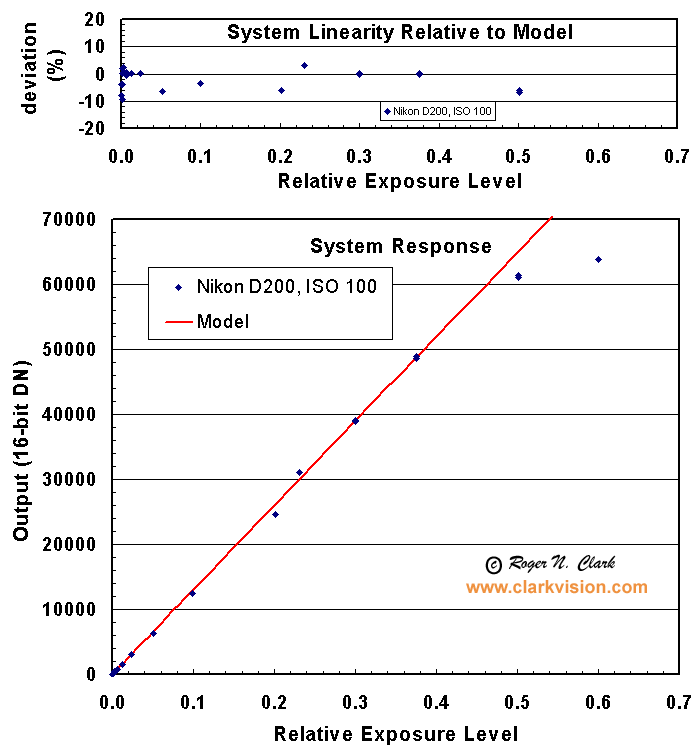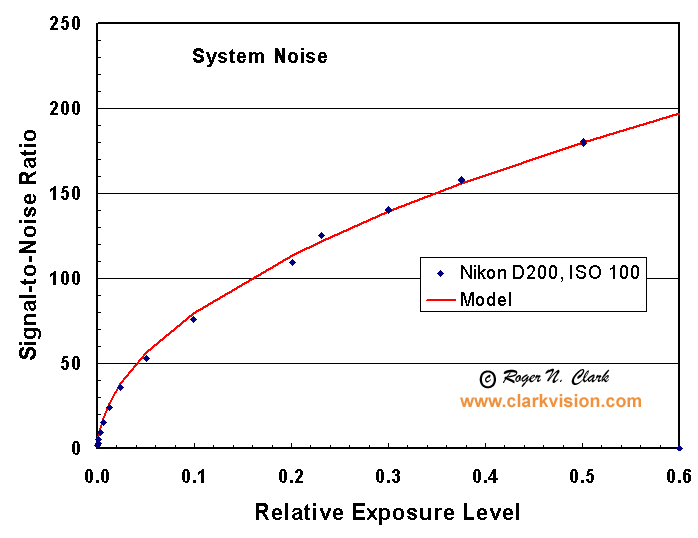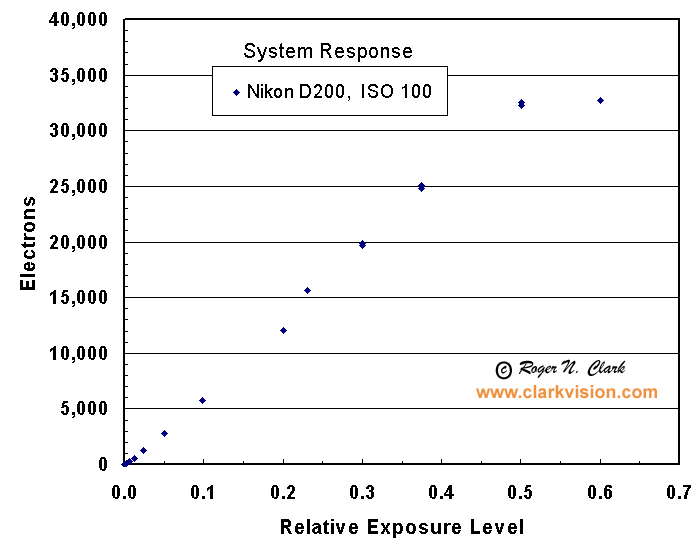
The Nikon D200 Digital Camera Review:
Sensor Noise, Dynamic Range, and Full Well Analysis
by Roger N. Clark
All images, text and data on this site are copyrighted.
They may not be used except by written permission from Roger N. Clark.
All rights reserved.
This page shows an analysis of noise, dynamic range, and full well capacity
of a Nikon D200 camera. Raw data were kindly supplied by Eric
Livo who gave permission to use the data for this analysis and its
publication.
Procedures for performing this analysis are described in:
Procedures for Evaluating Digital Camera Noise, Dynamic Range, and Full
Well Capacities; Canon 1D Mark II Analysis
The lowest possible noise from a
system detecting light is the noise due to Poisson statistics
from the random rate of arrival of photons. This is called
photon statistics, or photon noise. Noise from the electronics
will add to the photon noise. We will see that
the noise in Nikon D200 images is limited by photon statistics at high
signal levels and by electronic noise from reading the sensor
(called readout noise) at very low signal levels.
In the case of high signal levels, a system that is photon statistics
limited enables us to directly measure how many photons
the sensor captures, and by increasing the exposure, we can
determine how many photons are required to saturate the
sensor. That is called the full well capacity.
With data on the lowest noise to the highest signal, we can then
determine the dynamic range of the sensor.
Results
Results for determining read noise, gain, dynamic range and maximum
signal-to-noise ratio are shown in Table 1. Column B is the
gain derived from high signal data. Gains at ISOs
higher than 100 are scaled relative to that at ISO 100. Read noise,
Column C was determined from exposures with zero light on the sensor.
Maximum signal, column D, is 32,680 electrons at ISO 100 for the Nikon D200.
That maximum occurs at a signal level just below maximum A-to-D converter
output 3980/4096 in 12-bit data numbers (DN).
Dynamic range, Column E = maximum signal / read noise, and column
F shows that range in photographic stops.
Higher ISO reduces the maximum electrons (photons) that are recorded
relative to ISO 100 (e.g. ISO 400 sees half the electrons of ISO 200).
The maximum signal-to-noise ratio, Column G, is the square root of the
number of maximum photons recorded (e.g. square root 16,770 at ISO
200 = 129)
(read noise is negligible for the high signal case).
Table 1: Nikon D200: Derived Sensor Performance
A B C D E F G
Camera Apparent
ISO Gain Read Noise Maximum Dynamic Dynamic Maximum
(electrons/ (electrons) Signal Range Range Signal-to-Noise
12-bit DN) (electrons) (linear) (stops) Ratio
100 7.98 10.0 32,680 3,268 11.7 181
200 4.0 8.1 16,770 2,070 11.0 129
400 2.0 7.7 8,380 1,088 10.1 92
800 1.0 7.4 4,190 566 9.1 65
1600 0.5 7.4 2,100 284 8.1 46
An important factor in high ISO performance is collecting enough
photons. Small pixels have difficulty doing just that.
The Nikon D200 has pixels spaced every 6.1 microns (this is called
the pixel pitch).
The direct effect of the number of photons collected is the gain
needed to convert the signal from a pixel to a digital number.
The gain of the camera is given in column B in Table 1. Once
gain drops below 1 electron/DN, there is little point in
increasing ISO further. On the Nikon D200, unity gain
occurs at about ISO 800. The effect of higher
ISO above unity gain only decreases dynamic range
without helping to detect lower
signals. For comparison, unity gain of some large pixel DSLR
cameras (e.g. the Canon 1D Mark IIi with an 8.2 micron pixel
pitch) occurs around ISO 1300, and small pixel cameras (e.g.
the Canon S70 with 2.3 micron pixel pitch) have unity gain
near ISO 100. The unity gain ISO is an indication of the
effective sensitivity of the camera. The Nikon D200
unity gain level is similar to other DSLRs with approximately
6-micron pixel spacing.
The system linearity of the Nikon D200 is shown in Figure 1, and
is very good. System linearity includes the detector
linearity, shutter reproducibility, f/stop reproducibility, and light
source stability. At the very highest signals at ISO 100, the
Nikon D200 departs from linearity above about 60,000 in a 16-bit
tif file (within about 10% of saturation).
The signal-to-noise ratio as a function of intensity is
shown in Figure 2. If the sensor is photon noise limited, the trend
in this ratio is a square root dependence.
If the system is photon noise limited, the signal-to-noise
ratio squared directly equals the number of photons collected
without needing gain conversions, or computing the slope of a line.
The fact that the model matches the data very well indicates
there are no other sources of noise contributing to the data at any
significant level. Thus, for high signal levels, the Nikon D200 is
photon noise limited. This means further improvements in electronics
will not improve the signal-to-noise ratio for high signal levels.
If the quantum efficiency were improved with a different sensor, that
would certainly improve the signal-to-noise ratio.

Figure 1. The Nikon D200 shows a very linear trend with signal.
Variations in signal level include repeatability of the shutter and aperture,
as well as the light source.
The model is the average high signal DN scaled according to exposure
time and subtract read noise. The Nikon D200 shows some departure
from linearity with signals within about 10% of sensor saturation at
ISO 100.

Figure 2. Signal-to-noise ratio observed and predicted. The prediction
model uses photon statistics and read noise.
Model is average DN scaled to electrons plus read noise. For this case,
ISO 100, the gain in the model is 7.98 electrons/camera DN (4096 levels),
and the read noise is 10.0 electrons.

Figure 3. The electrons converted by the Nikon D200 sensor
are shown relative to an arbitrary exposure level. The
sensor saturates at about 32,680 electrons.
Dark Current and Related Noise
Another noise component is due to dark current, which will
increase with exposure time. Dark current and its noise is
also a function of the temperature of the sensor and associated
electronics.
Data to be added.
The noise model is:
N = (P + r2 + t2)1/2, (eqn 1)
Where N = total noise in electrons, P = number of photons, r = read noise
in electrons, and t = thermal noise in electrons. Noise from a stream of
photons, the light we all see and image with our cameras, is the square root
of the number of photons, so that is why the P in equation 1 is not squared
(sqrt(P)2 = P).
Conclusions
The data shown here for the Nikon D200 shows that the camera is
operating and near perfect levels for the sensor. This means that for
high signals, noise is dominated by photon statistics. Noise at low
signal levels is good but it would be nice to see a lower read
noise, something more like 4 electrons. To achieve higher
signal-to-noise ratio images, a higher quantum efficiency sensor with
a larger full well would be needed. Without increasing the full well
capacity, the maximum signal-to-noise ratio would not improve.
Improvements in quantum
efficiency of about 3 are possible (Reference 2), but currently that
would require much more expensive detectors, such as back-side
illuminated CCDs. Note some DSLRs have maximum full well capacities
on the order of 50,000 electrons (e.g. Canon 20D) to 80,000
electrons (e.g. Canon 1D Mark II), so the Nikon D200 is on the low
end of full well capacity.
For comparison with a larger pixel DSLR, compare Table 1
and the figures with that for the
Canon 1D Mark II Analysis.
Compare the Nikon D200 with the
Nikon D50 Analysis, which has a full well of 30,490 electrons
at ISO 200, almost double the D200.
References
1)
CCD Gain. http://spiff.rit.edu/classes/phys559/lectures/gain/gain.html
2)
Charge coupled CMOS and hybrid detector arrays
http://huhepl.harvard.edu/~LSST/general/Janesick_paper_2003.pdf
3)
Canon EOS 20D vs Canon EOS 10D and
Canon 10D / Canon 20D / Nikon D70 / Audine comparison
http://www.astrosurf.org/buil/20d/20dvs10d.htm
4)
http://www.photomet.com/library_enc_fwcapacity.shtml
5)
Astrophotography Signal-to-Noise with a Canon 10D Camera
http://www.clarkvision.com/astro/canon-10d-signal-to-noise
Notes:
DN is "Data Number." That is the number in the file for each
pixel. I'm quoting the luminance level (although red, green
and blue are almost the same in the cases I cited).
16-bit signed integer: -32768 to +32767
16-bit unsigned integer: 0 to 65535
Photoshop uses signed integers, but the 16-bit tiff is
unsigned integer (correctly read by ImagesPlus).
Back to:
Digital Camera Sensor Analysis pages on this site:
http://www.clarkvision.com/articles/index.html#sensor_analysis
http://www.clarkvision.com/reviews/evaluation-nikon-d200
First published September 16, 2006.
Last updated September 16, 2006


